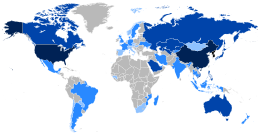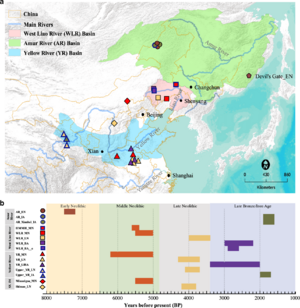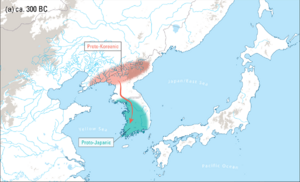Koreans facts for kids
| 한민족 • 조선민족 | |
|---|---|
| Total population | |
| c. 81 million | |
| Regions with significant populations | |
| South Korea c. 49,110,000 (2019) North Korea 25,955,138 Diaspora as of 2021[update] c. 7.3 million |
|
| 2,633,777 | |
| 2,109,727 | |
| 818,865 | |
| 237,364 | |
| 175,865 | |
| 168,526 | |
| 158,103 | |
| 156,330 | |
| 109,495 | |
| 47,428 | |
| 36,690 | |
| 36,540 | |
| 33,812 | |
| 33,032 | |
| 25,417 | |
| 22,847 | |
| 20,983 | |
| 18,130 | |
| 18,106 | |
| 17,297 | |
| 13,667 | |
| 13,524 | |
| 13,055 | |
| 11,107 | |
| 10,674 | |
| 10,608 | |
| 9,473 | |
| 8,694 | |
| 7,744 | |
| 5,132 | |
| 3,771 | |
| Languages | |
| Korean, Jeju and Korean Sign Language minorities |
|
| Religion | |
| Predominantly : Irreligious Significant : Korean shamanic, Christian, and Buddhist |
|
| Related ethnic groups | |
| Jejuans | |
Koreans are an East Asian ethnic group who originally come from Korea. Most Koreans live in North and South Korea. These two countries are often called Korea together.
As of 2021, about 7.3 million Koreans live outside of Korea. Many countries officially recognize Koreans as an ethnic minority. These include China, Japan, Kazakhstan, Russia, and Uzbekistan. Large Korean communities also exist in Germany, the United Kingdom, France, the United States, Canada, Australia, and New Zealand.
Contents
What Does "Korean" Mean?
People in South Korea call themselves Hanguk-in or Hanguk-saram. Both terms mean "people of Han." The word "Han" refers to the Three Kingdoms of Korea. These were ancient kingdoms, not the older groups in the southern Korean Peninsula. Koreans living outside Korea sometimes use the term Han-in.
People in North Korea call themselves Joseon-in or Joseon-saram. These terms mean "people of Joseon." Joseon was the last kingdom of Korea. It was named after Gojoseon, the first Korean kingdom.
Koreans in China are called Chaoxianzu in Chinese or Joseonjok in Korean. These words mean "Joseon ethnic group." Koreans in Japan use terms like Zainichi Chousenjin or Joseonin.
Ethnic Koreans in Russia and Central Asia are called Koryo-saram. This name comes from Goryeo, a Korean kingdom from 918 to 1392. The word 'Korea' also comes from 'Goryeo'.
In South Korea's national anthem, Aegukga, Koreans are called Daehan-saram. This means "People of Great Han." When talking about all Koreans, South Koreans use the term Hangyeore. This means "nations/people of Han."
Where Did Koreans Come From?
Scientists are still learning about where Koreans first came from. Based on language, old tools, and genetics, their origin is likely in Northeast Asia. However, how they moved into the Korean peninsula is still being studied.
Archaeologists think that early Koreans, called Proto-Koreans, moved from Manchuria during the Bronze Age. Many language experts agree that the original home of the Proto-Korean language was also in Manchuria. This was likely near the Liao River.
Later, people who spoke Koreanic languages moved to northern Korea. They then spread south, mixing with or replacing people who spoke Japonic languages. This might have led to the Yayoi migration to Japan. Some experts believe Proto-Koreans arrived in southern Korea around 300 BCE. They lived alongside or mixed with the descendants of Japonic farmers.
The arrival of early Koreans is linked to the Bronze Age dagger culture. This culture spread from the West Liao River region. Old pottery styles also show a link between this area and the Korean peninsula.
Korea has the most dolmens in the world. Dolmens are large stone tombs or monuments. There are about 35,000 to 100,000 dolmens in Korea. This is almost 40% of all dolmens worldwide. Similar dolmens are found in Northeast China and Japan.
Genetic Studies
Modern Koreans are mostly related to Bronze Age farmers from the West Liao River area. These farmers themselves came from a mix of two ancient groups. These were "Neolithic Yellow River farmers" and "Ancient Northeast Asians" (hunter-gatherers from the Amur region).
The spread of the Proto-Koreanic language is connected to these Bronze Age farmers. Their genes also spread to Japan during the Kofun period through early Koreanic-speakers. Studies show that Koreans from the Three Kingdoms Period had some Jōmon ancestry. However, later arrivals from Manchuria made Koreans more genetically similar to each other.
Koreans are genetically very similar to other modern East Asians. This includes Japanese, Southern Tungusic groups, and some northern Han Chinese groups. A 2021 study found that Koreans are genetically closest to Japanese people. They are also close to Northern Han Chinese.
Korean Culture
North Korea and South Korea share a common history and traditions. However, since the division in 1945, their modern cultures have become a bit different.
Language
The language spoken by Koreans is the Korean language. It uses a writing system called Hangul. Sejong the Great, a Korean king, invented Hangul.
In daily life, Hanja (Chinese characters) are not used much in Korea anymore. Some South Korean newspapers still use them for important politicians or certain countries. Otherwise, Hanja is mainly for school, history, and religious texts. The Roman alphabet is also used a lot in South Korea, especially for words borrowed from other languages. More than 78 million people around the world speak Korean.
Where Koreans Live
Large numbers of Koreans started moving out of Korea in the mid-1860s. They mainly went to the Russian Far East and Northeast China. These groups grew to over two million Koreans in China and hundreds of thousands of Koryo-saram (ethnic Koreans in Central Asia and former Soviet Union countries).
During the time Korea under Japanese rule (1910–1945), many Koreans were forced to work in Japan and other areas. Those who stayed in Japan after the war are called Zainichi Koreans. About 40,000 Koreans were stuck in Sakhalin after the Soviet invasion. They are known as Sakhalin Koreans.
South Korea's Population
In June 2012, South Korea's population reached 50 million. By the end of 2016, it was over 51 million. Since the 2000s, South Korea has had a very low birthrate. Some researchers think the population might shrink to about 38 million by the end of the 21st century if this trend continues. In 2018, South Korea had the lowest birth rate in the world.
North Korea's Population
It has been hard to know the exact population numbers for North Korea. This includes how many people there are, how fast the population grows, and how many males and females there are. Until 1989, North Korea did not share much official data.
In 1989, North Korea shared some population data with the United Nations Population Fund. This was to get help for their first nationwide census since 1948. It seems North Korea has become a bit more open about its population data.
Koreans Around the World
Koreans started moving to the U.S. as early as 1903. However, the Korean American community grew much larger after 1965. As of 2017, about 1.85 million Koreans and people of Korean descent live in the United States. This number does not include those without documents.
The Greater Los Angeles Area and New York metropolitan area have the largest groups of Koreans outside of Korea or China. Korean Americans save more money and graduate from college at higher rates than the U.S. average. This means they contribute many skilled professionals to the American workforce. In 2021, the average household earnings for Korean Americans were higher than the U.S. average.
Many Koreans also live in China, Japan, Argentina, Brazil, and Canada. The number of Koreans in Indonesia grew in the 1980s. In the 1990s and 2000s, more Koreans moved to the Koreans in the Philippines and Koreans in Vietnam.
In Central Asia, many Koreans live in Uzbekistan and Kazakhstan. Some also live in parts of Russia, including the Far East. These groups are called Koryo-saram. Many of them are descendants of Koreans who were forced to move during the Soviet Union's Stalin era. The Korean community in Uzbekistan is the fifth largest outside Korea.
The Koreans in the United Kingdom now form the largest Korean community in Western Europe. Koreans in Germany used to be more numerous until the late 1990s. In Australia, Korean Australians are a smaller group. Koreans have been moving to many places since the 1960s.
People with Mixed Korean Heritage
There are people with mixed Korean and other backgrounds. For example, Kopinos are people with both Filipino and Korean parents. In 2020, it was estimated there were about 30,000 Kopinos.
Lai Đại Hàn is a Vietnamese term. It refers to children born to South Korean men and South Vietnamese women during the Vietnam War. There is no exact number for them. However, one Korean scholar estimates there are at least 5,000 to 150,000 Lai Dai Han around the world. Many of them choose not to share their Korean roots.
See also
 In Spanish: Pueblo coreano para niños
In Spanish: Pueblo coreano para niños
- Demographics of South Korea
- Ethnic groups in Asia
- History of Korea
- Koreatown
Images for kids







